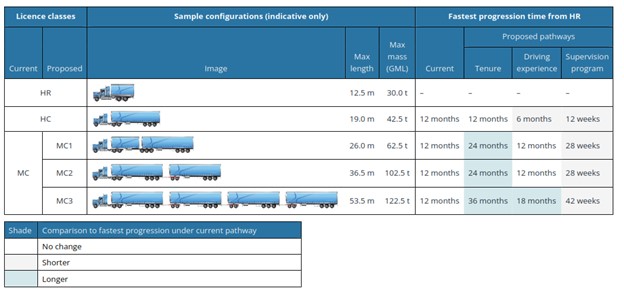National Heavy Vehicle Competency Framework
DR ELIZABETH GIBSON, General Manager of the CMPA provides a summary of the NHVDCF together with CMPA’s submission (28 October 2022).
Introduction
The National Heavy Vehicle Driver Competency Framework (NHVDCF) was developed collaboratively by governments to establish minimum competency and assessment standards for heavy vehicle drivers across Australia. It is intended to provide a framework that is adopted by all jurisdictions in their heavy vehicle licensing regimes to ensure a nationally consistent approach to heavy vehicle driver training and competency assessment. The following is a brief summary from the NHVDCF Consultation RIS developed by Austroads and available at: https://austroads.com.au/drivers-and-vehicles/registration-and-licensing/heavy-vehicle-driver-competency-framework/c-ris
Objectives of the reform
The proposed reforms to the NHVDCF considered in this Consultation RIS are aimed at achieving the following objectives:
• delivering improved road safety outcomes with respect to heavy vehicles
• not compromising the availability of heavy vehicle drivers and supporting the use of high productivity vehicles
• providing reasonable access to heavy vehicle licences for social and personal benefit.
Research
Industry input and research has identified the following as being key factors that influence the risk of a heavy vehicle driver crashing, and that are not currently adequately considered in the NHVDCF and in jurisdictional heavy vehicle licensing arrangements.
- Experience: The more experience a heavy vehicle driver has the less likely they are to crash, all other things being equal. However, the current licence progression system is based on tenure. Tenure does not guarantee that a person has had any, or substantive, behind-the- wheel experience. Instead, this places an arbitrary time-based barrier on a driver’s ability to take on employment involving more complex heavy vehicles, which may exacerbate issues around driver shortages at higher licensing classes without delivering improvements in safety. In addition, there is evidence and industry support for increased focus on behind – the-wheel training and supervision as part of pre-, and potentially post, licensing programs. There is also evidence to support the need for greater light vehicle experience for young drivers before they commence driving most heavy vehicles.
- Past driving behaviour and offences: Modelling undertaken in Victoria has found that heavy vehicle drivers with a past history of serious offences have a significantly higher risk of crashing. This risk factor is not considered in the heavy vehicle licensing regime.
- Other knowledge and skills: Some factors now understood to be important to improving the road safety awareness of heavy vehicle drivers are not currently covered or tested by the NHVDCF. These include hazard awareness and other core skills and knowledge necessary to safely drive a heavy vehicle such as how to secure loads, reverse, couple and uncouple trailers.
Reform options
Each option builds upon the previous options. In other words, Option 3 incorporates all the elements in Option 1 and 2 plus additional measures. It is important to note that the packaging of the proposed elements into three options does not imply that elements need to be introduced as a package.

Progression pathways

MR: Medium Rigid HR: Heavy Rigid HC: Heavy Combination MC: Multiple Combination
Figure 3: Proposed progression pathways by licence class.

Submission
CMPA provided the following submission:
CMPA strongly supports that Australia needs well-trained and capable heavy vehicle drivers which starts with effective licensing. Additionally, CMPA gives in principal support to the approach being proposed by the Consultation RIS to improve safety on roads through:
1 Managing individual driver risk
Ensuring eligibility only for drivers without serious driving offences and with sufficient light vehicle experience before gaining their first heavy vehicle licence.
2 Strengthening skill and knowledge development
Making competency requirements specific to each licence class, setting minimum course length, and recognising the extra skill needed to drive the most complex vehicles.
3 Embedding behind-the-wheel experience
Minimum behind-the-wheel pre-licence requirements and post-licence supervised driving.
4 Introducing experience-based progression options
Enabling those drivers who have demonstrated driving and work experience to progress more rapidly.
• The expectations are that the training sector will need to address competencies being assessed by tenure more than short courses, which seems sensible.
• It is understood that application of the approach will not be retrospective (where safe to do so) so that in the short-term further driver shortages will not occur.
• Concerns were raised during the consultation webinar about the proposed amount of online training. Our experience is that online offerings for inductions as an example have a very poor uptake due to language and device use limitations. The training sector may need to have group training facilities available to assist with those issues.
Summary
The CMPA gives in principal support for the direction proposed in the Consultation RIS but would like to be consulted as the model is further developed.









You must be logged in to post a comment Login